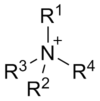Cationic surfactants
As cationic surfactants refers to surfactants having a positively charged functional group and not in addition possess a negatively charged group. Like every surfactant, the cationic surfactants are made up of a polar and a non-polar part. Various alkyl groups serve as the non-polar part . The polar group is mostly a quaternary ammonium unit, so they are often tetraalkylammonium salts .
structure
Most cationic surfactants are quaternary ammonium compounds (quats). They only differ in the alkyl radicals:
R 1 , R 2 , R 3 , R 4 : alkyl radicals (typically stearyl, palmityl, methyl, benzyl, butyl)
X - : counterion, mostly halide
Cationic surfactants of the general formula R 4 N + are also referred to as invert soaps .
Typical representatives
DSDMAC is the surfactant that was used in fabric softeners in the 1990s . However, it is characterized by very poor biodegradability . So-called ester quats have recently been used. Esterquats are based on quaternary triethanol-methyl-ammonium or quaternary diethanol-dimethyl-ammonium compounds. The necessary long hydrocarbon chains are attached as fatty acid esters . These are easily split off again during biological degradation, which is very advantageous, at least as a first step for degradation.
use
Cationic surfactants are used as a component in fabric softeners for textile cleaning .
Furthermore, due to their hydrophobic effect , cationic surfactants are used as drying aids, for. B. used in car washes or as a water repellent.
They are also used as transfection agents for the DNA molecules in molecular biology . Their ability to form micellar or liposomal structures is used here.
The invert soap Zephirol was previously used in combination with alcohol for surgical hand disinfection .
Cationic surfactants are used as a component in phase transfer catalysis , in which water-soluble anions are transferred through hydrophobic quats into the hydrophobic organic phase in order to react there in a homogeneous reaction field.
Cetyltrimethylammonium bromide is used as a detergent in the CTAB-Page method , a polyacrylamide gel electrophoresis , in order to obtain the correct molecular mass for strongly positively charged proteins (such as histones ) and to get sharp bands in the case of glycoproteins .
Use as a disinfectant
Certain cationic surfactants also have a biocidal effect and are therefore used as disinfectants ( antiseptics ). These include:
- Benzalkonium chloride
- Benzethonium chloride
- Cetylalkonium chloride
- Cetyl pyridinium chloride
- Cetyltrimethylammonium bromide (cetrimonium bromide)
- Dequalinium chloride
swell
- Anatomical-therapeutic-chemical classification with daily doses. Official version of the ATC index with DDD information for Germany in 2008 . PDF
- HJ Roth, H. Fenner: Medicines . 1st edition. Thieme, Stuttgart a. New York 1988, pp. 171-172.
Individual evidence
- ↑ Entry on invert soaps. In: Römpp Online . Georg Thieme Verlag, accessed on January 10, 2017.
- ^ S. Mishra, VK Tyagi: Esterquats: the novel class of cationic fabric softeners. In: Journal of Oleo Science. Volume 56, Number 6, 2007, pp. 269-276, PMID 17898491 (review).
- ↑ Hans Ferdinand Marquardt : The triggering of chromosome mutations by X-rays and by the invert soap Zephirol in the meiosis of Oenothera hookeri. In: Molecular and General Genetics. Volume 83, 1949, No. 5, pp. 513-530.
- ↑ Hans Killian : There is only God behind us. Sub umbra dei. A surgeon remembers. Kindler, Munich 1957; here: Licensed edition as Herder paperback (= Herder library. Volume 279). Herder, Freiburg / Basel / Vienna 1975, ISBN 3-451-01779-2 , p. 88.
- ↑ General theory of phase transfer catalysis script from Bielefeld University, accessed on July 28, 2020
- ↑ Engelbert Buxbaum: Cationic electrophoresis and electrotransfer of membrane glycoproteins . In: Analytical Biochemistry . tape 314 , no. 1 , March 2003, p. 70-76 , doi : 10.1016 / S0003-2697 (02) 00639-5 .




